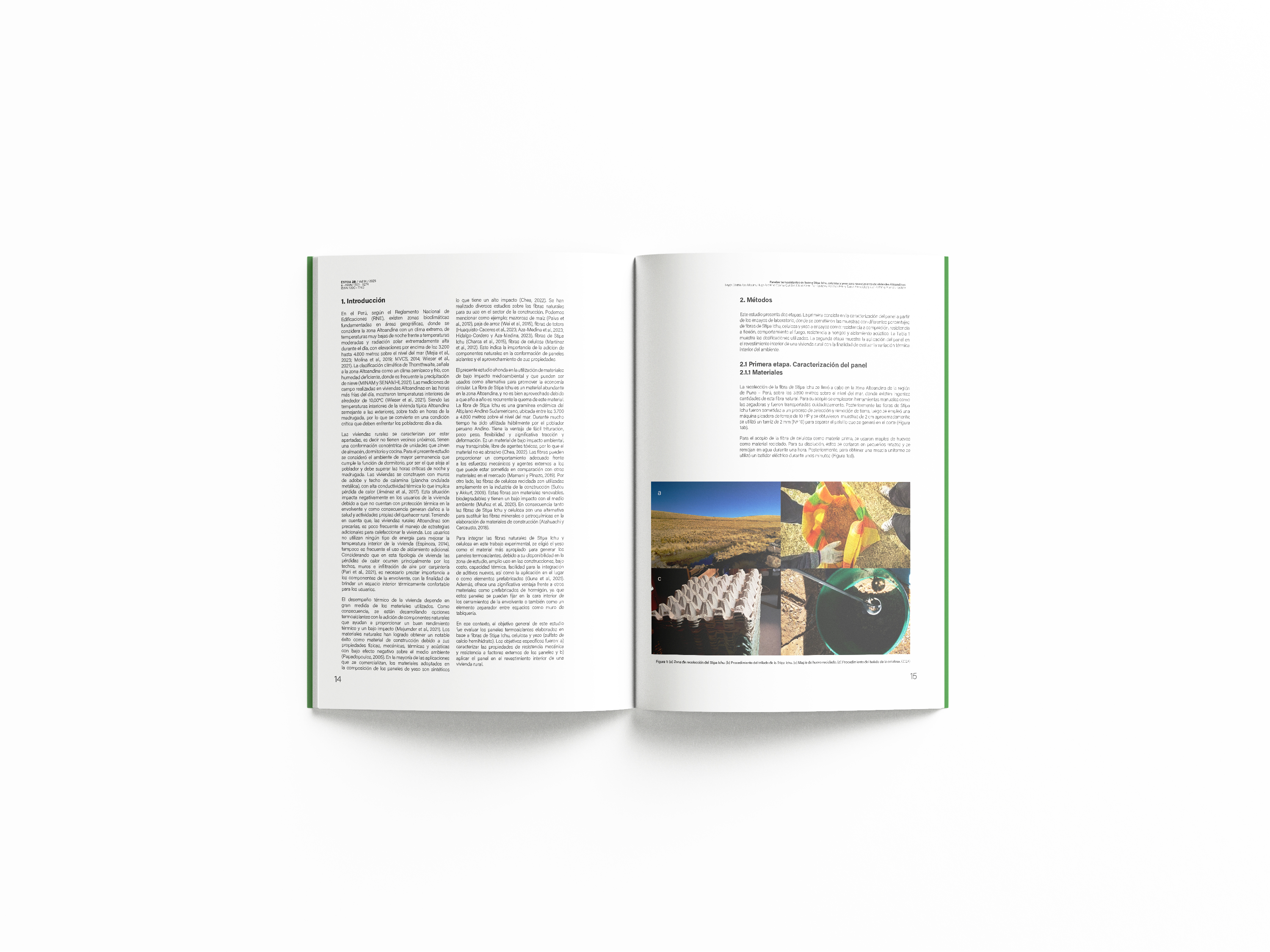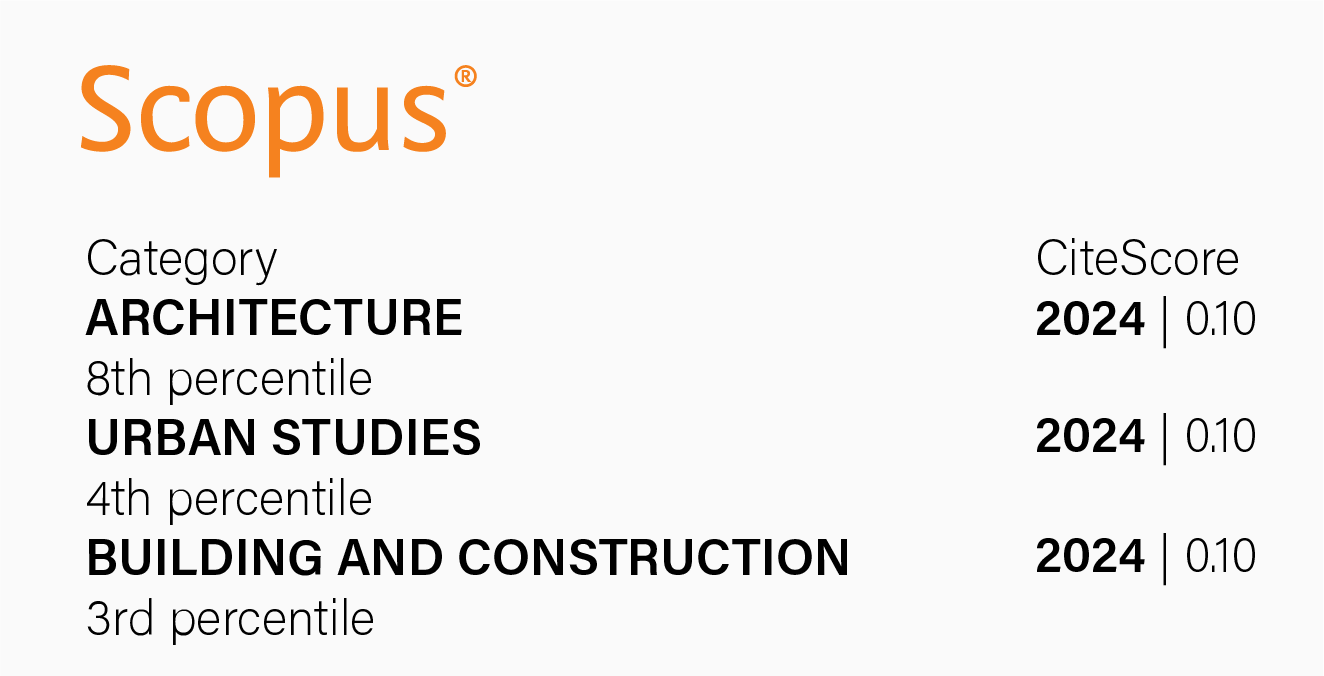Thermo-insulating panels based on Stipa Ichu, cellulose and gypsum for high Andean housing claddings
DOI:
https://doi.org/10.18537/est.v014.n028.a01Keywords:
natural insulators, vegetable fibre, gypsum, thermal performance, ecological materialsAbstract
The manufacture of construction materials with conventional inputs generates negative impacts on the environment and contributes significantly to energy consumption. Therefore, facing this problem requires new alternatives. This research proposes a thermo-insulating panel made of Stipa Ichu fibers, cellulose, and gypsum for its application in a High Andean house. In order to evaluate the panel, its resistance to compression, bending, fire, fungus and acoustic insulation was characterized. Subsequently, the thermal behavior in the interior lining of a house was evaluated. The results reveal a compressive strength of 28.30 kg/cm2, flexural strength of 18.35 kg/cm2. The 12.50 mm thick panel showed a fire resistance of more than 60 minutes, 30% absorption and 70% noise reflectance, as well as adequate durability against fungi. With respect to thermal behavior, this thermo-insulating panel increases the interior temperature by 2.30°C with respect to a typical house, which makes its use feasible.
Downloads
References
Atahuachi, G. y Carcausto, Y. (2018). Aislante termoacústico a base de Stipa Ichu para atenuar el ruido y cambios drásticos de temperatura en viviendas de sectores en expansión urbana de la ciudad de Puno. [Tesis, Universidad Nacional del Altiplano]. Repositorio institucional de la Universidad Nacional del Altiplano. https://www.repositorio.unap.edu.pe/handle/20.500.14082/11138
Aza-Medina, L. C., Palumbo, M., Lacasta, A. M., & González-Lezcano, R. A. (2023). Characterization of the thermal behavior, mechanical resistance, and reaction to fire of totora (Schoenoplectus californicus (C.A. Mey.) Sojak) panels and their potential use as a sustainable construction material. Journal of Building Engineering, 69, 1-16. https://doi.org/10.1016/j.jobe.2023.105984
Charca, S., Noel, J., Andia, D., Flores, J., Guzman, A., Renteros, C., & Tumialan, J. (2015). Assessment of Ichu fibers as non-expensive thermal insulation system for the Andean regions. Energy and Buildings, 108, 55–60. https://doi.org/10.1016/j.enbuild.2015.08.053
Chea, F. (2022). Estudio de la fibra de Ichu incorporada como aislante térmico a un sistema de construcción en seco para su uso en envolventes de viviendas rurales ubicadas en zonas climáticas frías del Perú. [Tesis de Maestría, Pontificia Universidad Católica del Perú]. http://hdl.handle.net/20.500.12404/24625
Corrales, M. (2012). Sistema solar pasivo más eficaz para calentar viviendas de densidad media en Huaraz. [Tesis de Maestría, Universidad Nacional de Ingeniería]. Repositorio institucional de la Universidad Nacional de Ingeniería. http://cybertesis.uni.edu.pe/bitstream/uni/1363/1/guerra_jt.pdf
Espinoza, R. (2014) Evaluación experimental de la performance de dos componentes bioclimáticos de calentamiento aplicadas en un módulo de vivienda de San Francisco de Raymina-Ayacucho. [Tesis de Maestría, Universidad Nacional de Ingeniería]. Publicación Concytec. https://hdl.handle.net/20.500.12390/2103
Espinoza, R. L. (2009). Evaluación experimental de cambios constructivos para lograr confort térmico en una vivienda Altoandina del Perú. Avances en Energías Renovables y Medio Ambiente, 13, 1-8. http://sedici.unlp.edu.ar/handle/10915/97335
Flores, A. (2014). Construcción de una vivienda solar en base a las propiedades termofísicas y evaluación experimental de su confort térmico en Ilave. Revista de Investigaciones Altoandinas, 16(1), 177-186. https://dialnet.unirioja.es/servlet/articulo?codigo=5893905
Guna, V., Yadav, C., Maithri, B. R., Ilangovan, M., Touchaleaume, F., Saulnier, B., Grohens, Y., & Reddy, N. (2021). Wool and coir fiber reinforced gypsum ceiling tiles with enhanced stability and acoustic and thermal resistance. Journal of Building Engineering, 41, 1-9. https://doi.org/10.1016/j.jobe.2021.102433
Hidalgo-Cordero, J. F., & Aza-Medina, L. C. (2023). Analysis of the thermal performance of elements made with totora using different production processes. Journal of Building Engineering, 65, 1-12. https://doi.org/10.1016/j.jobe.2022.105777
Huaquisto-Cáceres, S., Pari-Quispe, D. K., & Cruz-Maron, R. A. (2023). Eco-efficient thermoacoustic panels made of totora and gypsum for sustainable rural housing ceilings. Materiales de Construcción, 73(352), 1-12. https://doi.org/10.3989/mc.2023.346323
Jiménez, C., Wieser, M., & Biondi, S. (2017). Improving Thermal Performance of cabins in the High-Altitude Peruvian Andean Region, 3. PLEA 2017 Proceedings (pp. 4101-4108). https://repositorio.pucp.edu.pe/index/handle/123456789/187754
Jiménez-Dianderas, G. C., Montoya Robles, T. del P., y Loayza León, S. (2024). De la “Quesana” tradicional a un sistema modular de paneles aislantes de Totora. Revista de Arquitectura, 26(1), 125–146. https://doi.org/10.14718/revarq.2024.26.4578
Majumder, A., Canale, L., Mastino, C. C., Pacitto, A., Frattolillo, A., & Dell’isola, M. (2021). Thermal characterization of recycled materials for building insulation. Energies, 14(12), 1-16. https://doi.org/10.3390/en14123564
Mamani, E., y Pinazo, L. (2019). Eficiencia de una vivienda construida con tabiquería bioclimática a base del Stipa Ichu y festuca Dolichophylla Presl para mejorar el confort térmico en la zona de Chillapalca, San Antonio de Putina, de la región Puno. [Tesis de Pregrado, Universidad Nacional del Altiplano]. Repositorio institucional de la Universidad Nacional del Altiplano. http://repositorio.unap.edu.pe/handle/20.500.14082/15745
Martínez, C., Cortés, T. & Corpas, F. A. (2012) Recovering wastes from the paper industry: development of ceramic materials. Fuel Processing Technology. 103, 117–124. http://dx.doi.org/10.1016/j.fuproc.2011.10.017.
Mejia, E., Arias, J., Palm, B. (2023). Simple solutions for improving thermal comfort in huts in the highlands of Peru. Heliyon, 9, 1-14. https://doi.org/10.1016/j.heliyon.2023.e19709.
Ministerio del Ambiente – MINAN y Servicio Nacional de Meteorología e Hidrología del Perú - SENAMHI (2021). Climas del Perú - Mapa de Clasificación Climática Nacional. https://www.senamhi.gob.pe/load/file/01404SENA-4.pdf
Ministerio de Vivienda Construcción y Saneamiento - MVCS (2014). Confort térmico y lumínico con eficiencia energética (Norma Núm. EM. 110). https://www.gob.pe/institucion/munisantamariadelmar/informes-publicaciones/2619729-em-110-confort-termico-y-luminico-con-eficiencia-energetica
Molina, J. O., Espinoza, R. E., Horn, M. J., & Gómez, M. M. (2019). Thermal performance evaluation of isolation and two active solar heating systems for an experimental module: A rural Peruvian case at 3700 masl. Journal of Physics: Conference Series, 1173(1). https://doi.org/10.1088/1742-6596/1173/1/012003
Muñoz, P., Letelier, V., Zamora, D., & Morales, M. P. (2020). Feasibility of using paper pulp residues into fired clay bricks. Journal of Cleaner Production, 262. https://doi.org/10.1016/j.jclepro.2020.121464
Ordóñez Cristian. (2020). Elaboración de un panel prefabricado de yeso con fibras naturales, como alternativa para acabado de la construcción de cielo raso y paredes. [Tesis de Pregrado, Universidad Católica de Cuenca]. Repositorio institucional de la Universidad Católica de Cuenca. https://dspace.ucacue.edu.ec/handle/ucacue/10325
Paiva, A., Pereira, S. Sá, A., Cruz, D., Varum, H., & Pinto, J. A. (2012). Contribution to the thermal insulation performance characterization of corncob particleboards, Energy and Buildings, 45, 274–279, https://doi.org/10.1016/j.enbuild.2011.11.019
Papadopoulos, A. M. (2005). State of the art in thermal insulation materials and aims for future developments. Energy and Buildings, 37(1), 77–86. https://doi.org/10.1016/j.enbuild.2004.05.006
Pari, D., Cronemberger, J., y Frederico, C. (2021). Confort térmico en viviendas sociales en la zona Mesoandina de Perú – soluciones para mejorar la calefacción pasiva usando materiales autóctonos. Revista Latino-Americana de Ambiente Construído & Sustentabilidade, 2(6), 1–12. https://doi.org/10.17271/rlass.v2i6.2980
Saavedra, G. G. (2014). Diseño, construcción y evaluación térmica de un módulo de vivienda rural en la localidad de Vilcallamas arriba, distrito de Pisacoma, provincia de Chucuito, región Puno. [Tesis de Maestría, Universidad Nacional de Ingeniería]. Repositorio institucional de la Universidad Nacional de Ingeniería. http://hdl.handle.net/20.500.14076/4484
Sutcu, M. & Akkurt, S. (2009). The use of recycled paper processing residues in making porous brick with reduced thermal conductivity, Ceramics International, 35(7), 2625–2631, http://dx.doi.org/10.1016/j.ceramint.2009.02.027
Wei, K., Lv, C., Chen, M., Zhou, X., Dai, Z., & Shen, D. (2015). Development and performance evaluation of a new thermal insulation material from rice straw using high frequency hot-pressing. Energy and Buildings, 87, 116–122. https://doi.org/10.1016/j.enbuild.2014.11.026
Wieser, M., Rodríguez-Larraín, S., y Onnis, S. (2021). Estrategias bioclimáticas para clima frío tropical de altura: Validación de prototipo de vivienda. Puno, Perú. Estoa, 10(19), 9–19. https://doi.org/10.18537/est.v010.n019.a01

Published
How to Cite
Issue
Section
License
Copyright (c) 2025 Estoa. Journal of the Faculty of Architecture and Urbanism

This work is licensed under a Creative Commons Attribution-NonCommercial-ShareAlike 4.0 International License.
The Journal declines any responsibility for possible conflicts derived from the authorship of the works that are published in it.
The University of Cuenca in Ecuador conserves the patrimonial rights (copyright) of the published works and will favor the reuse of the same ones, these can be: copy, use, diffuse, transmit and expose publicly.
Unless otherwise indicated, all contents of the electronic edition are distributed under a Creative Commons Attribution-NonCommercial-ShareAlike 4.0 International License.



